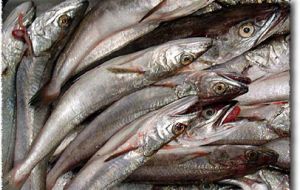MercoPress. South Atlantic News Agency
Alarming contraction of hake biomass in Argentine breeding grounds
 Argentina’s main fisheries export again seriously threatened
Argentina’s main fisheries export again seriously threatened The breeding grounds of common hake (Merluccius hubbsi) located in the San Jorge gulf, Argentine Patagonia are showing alarming signs of a loss of biomass, concludes a report authored by the National Institute for Fisheries Research and Development, (INIDEP).
INIDEP Technical Report 9/2010 reveals that the index of abundance of juveniles dropped an average of 60% over the last twelve months.
”The value of the index for the group age 2 (24 -32 centimetres) in 2010 registered a fall of 69% with respect to 2009, remaining at a level similar to that of 2008”, according to INIDEP, Pescare reports.
Meanwhile, the preliminary value of the index for age 1 (15 -23 cm) underwent an inter-annual diminution of 53%, leaving behind the slight growth it had registered in 2009.
With these numbers the future of the fishery and its commercial activity are under threat.
“It must be pointed out that although the adults registered have been partly strengthened this year thanks to the extraordinary age 2 group level registered in 2009, the indices for the present groups of ages 0 and 1 are the lowest of the last three years”.
The data included in this technical work arose from the survey carried out in January 2010 to analyse the distribution and structure of the common hake population in the North Patagonian breeding area.
The surveyed area mainly includes the waters of the San Jorge gulf in the South West Atlantic and its adjacent platform, to a depth of 100 metres.
The average hourly yields in weight obtained showed a progressive reduction from 2005 to 2007 in all the area, with the subsequent increase in 2009, the INIDEP scientists indicated. Nevertheless, a significant backward movement in the Gulf was detected last year, especially in the central-south sector.
”A diminution of 55% was registered, returning to the level found in 2008,” the report's authors indicate. The Institute experts confirmed the need to implement measures that protect developing units, involving both hake as prawn (Pleoticus muelleri).
Norberto Yaugar, head of the Argentina’s Fisheries Under-Secretariat announced last week that all shrimp vessels will have to operate with the Disela and Hargril selectivity devices.
Additionally Yaugar urged the restoration of the use of the DEJUPA device to the rest of the fleet and a considerable reduction cut in the fishing effort targeting common hake in the gulf. They are currently under consideration by the Federal Fisheries Council, CFP.
In support of the INIDEP report, the latest statistics released by the Fisheries department indicate that 60.983 tons of hake were landed between 1 January and 16 April in Argentine ports. This volume reflects a loss of 24.3% compare to the 80.469 tons of the same period 2009. Of total landings this year, 59.397 tons were captured south of parallel 41° and 1,585.4 tons to the north. (FIS/MP).




Top Comments
Disclaimer & comment rulesCommenting for this story is now closed.
If you have a Facebook account, become a fan and comment on our Facebook Page!